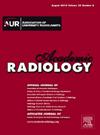An Interdisciplinary Approach Toward Developing an Engaging and Clinically Relevant Medical Imaging Curriculum
IF 3.8
2区 医学
Q1 RADIOLOGY, NUCLEAR MEDICINE & MEDICAL IMAGING
引用次数: 0
Abstract
Rationale and Objectives
Competency in imaging is essential for physicians to diagnose and manage disease. Previously, the authors introduced radiology education in the anatomy lab. The present study transitioned the radiology education to the classroom with the primary goal of increasing engagement and clinical relevance.
Materials and Methods
To accomplish these objectives, a team of senior medical students, residents, a diagnostic radiologist, and an anatomist collaborated to design pre-work e-modules and active learning workshops focused on imaging five body regions. For three regions, interactive e-modules with built-in quizzes and videos were designed. PowerPoints were used for the other two regions. Pacsbin, a web-based Digital Imaging and Communications in Medicine viewer, was used as a platform to introduce students to the basics of windowing, scrolling and labeling images. Workshops focused on 3–4 cases which instructed groups of students to scroll through and label anatomical structures on scans uploaded to Pacsbin. A questionnaire seeking students’ feedback on the curriculum was given at the end of the course.
Results
Students indicated high satisfaction with the imaging curriculum, believing that it supported their anatomical knowledge. The majority of students preferred the e-modules as opposed to PowerPoints for learning the imaging anatomy. Pacsbin was most often used only during workshops. Students’ responses regarding their confidence with use Pacsbin were almost evenly distributed on a 4-point Likert scale.
Conclusions
Overall, this work presents an interdisciplinary way by which imaging can be incorporated into the pre-clinical medical curriculum in an engaging and clinically relevant manner.
跨学科方法:开发具有吸引力和临床相关性的医学影像课程。
理由和目标:成像能力对医生诊断和管理疾病至关重要。此前,作者在解剖实验室引入了放射学教育。本研究将放射学教育过渡到课堂,主要目标是提高参与度和临床相关性:为了实现这些目标,一个由高年级医学生、住院医师、放射诊断医师和解剖学家组成的团队合作设计了工作前电子模块和主动学习研讨会,重点关注五个身体区域的成像。针对三个区域设计了内置测验和视频的互动电子模块。另外两个区域则使用 PowerPoint。Pacsbin 是一个基于网络的医学数字成像和通信浏览器,被用作向学生介绍窗口、滚动和标记图像基础知识的平台。研讨会主要针对 3-4 个案例,指导学生分组滚动浏览并标注上传到 Pacsbin 的扫描图像上的解剖结构。课程结束时发放了一份调查问卷,征求学生对课程的反馈意见:结果:学生对成像课程非常满意,认为该课程有助于他们掌握解剖学知识。与 PowerPoints 相比,大多数学生更喜欢使用电子模块来学习影像解剖学。Pacsbin 最常用于研讨会。学生们对使用 Pacsbin 的信心在 4 点李克特量表上几乎是平均分布的:总之,这项研究提出了一种跨学科的方法,可将影像学以引人入胜且与临床相关的方式纳入临床前医学课程。
本文章由计算机程序翻译,如有差异,请以英文原文为准。
求助全文
约1分钟内获得全文
求助全文
来源期刊

Academic Radiology
医学-核医学
CiteScore
7.60
自引率
10.40%
发文量
432
审稿时长
18 days
期刊介绍:
Academic Radiology publishes original reports of clinical and laboratory investigations in diagnostic imaging, the diagnostic use of radioactive isotopes, computed tomography, positron emission tomography, magnetic resonance imaging, ultrasound, digital subtraction angiography, image-guided interventions and related techniques. It also includes brief technical reports describing original observations, techniques, and instrumental developments; state-of-the-art reports on clinical issues, new technology and other topics of current medical importance; meta-analyses; scientific studies and opinions on radiologic education; and letters to the Editor.
 求助内容:
求助内容: 应助结果提醒方式:
应助结果提醒方式:


